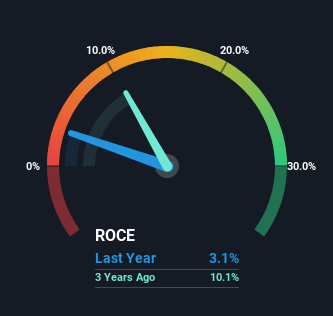- Malaysia
- /
- Semiconductors
- /
- KLSE:UNISEM
Unisem (M) Berhad (KLSE:UNISEM) Is Reinvesting At Lower Rates Of Return
Finding a business that has the potential to grow substantially is not easy, but it is possible if we look at a few key financial metrics. Firstly, we'd want to identify a growing return on capital employed (ROCE) and then alongside that, an ever-increasing base of capital employed. Ultimately, this demonstrates that it's a business that is reinvesting profits at increasing rates of return. However, after briefly looking over the numbers, we don't think Unisem (M) Berhad (KLSE:UNISEM) has the makings of a multi-bagger going forward, but let's have a look at why that may be.
Understanding Return On Capital Employed (ROCE)
Just to clarify if you're unsure, ROCE is a metric for evaluating how much pre-tax income (in percentage terms) a company earns on the capital invested in its business. To calculate this metric for Unisem (M) Berhad, this is the formula:
Return on Capital Employed = Earnings Before Interest and Tax (EBIT) ÷ (Total Assets - Current Liabilities)
0.031 = RM82m ÷ (RM3.1b - RM473m) (Based on the trailing twelve months to June 2024).
Thus, Unisem (M) Berhad has an ROCE of 3.1%. Ultimately, that's a low return and it under-performs the Semiconductor industry average of 8.3%.
See our latest analysis for Unisem (M) Berhad

Above you can see how the current ROCE for Unisem (M) Berhad compares to its prior returns on capital, but there's only so much you can tell from the past. If you'd like to see what analysts are forecasting going forward, you should check out our free analyst report for Unisem (M) Berhad .
What The Trend Of ROCE Can Tell Us
When we looked at the ROCE trend at Unisem (M) Berhad, we didn't gain much confidence. Around five years ago the returns on capital were 6.2%, but since then they've fallen to 3.1%. However it looks like Unisem (M) Berhad might be reinvesting for long term growth because while capital employed has increased, the company's sales haven't changed much in the last 12 months. It may take some time before the company starts to see any change in earnings from these investments.
What We Can Learn From Unisem (M) Berhad's ROCE
To conclude, we've found that Unisem (M) Berhad is reinvesting in the business, but returns have been falling. Yet to long term shareholders the stock has gifted them an incredible 279% return in the last five years, so the market appears to be rosy about its future. Ultimately, if the underlying trends persist, we wouldn't hold our breath on it being a multi-bagger going forward.
One final note, you should learn about the 2 warning signs we've spotted with Unisem (M) Berhad (including 1 which is significant) .
While Unisem (M) Berhad may not currently earn the highest returns, we've compiled a list of companies that currently earn more than 25% return on equity. Check out this free list here.
New: AI Stock Screener & Alerts
Our new AI Stock Screener scans the market every day to uncover opportunities.
• Dividend Powerhouses (3%+ Yield)
• Undervalued Small Caps with Insider Buying
• High growth Tech and AI Companies
Or build your own from over 50 metrics.
Have feedback on this article? Concerned about the content? Get in touch with us directly. Alternatively, email editorial-team (at) simplywallst.com.
This article by Simply Wall St is general in nature. We provide commentary based on historical data and analyst forecasts only using an unbiased methodology and our articles are not intended to be financial advice. It does not constitute a recommendation to buy or sell any stock, and does not take account of your objectives, or your financial situation. We aim to bring you long-term focused analysis driven by fundamental data. Note that our analysis may not factor in the latest price-sensitive company announcements or qualitative material. Simply Wall St has no position in any stocks mentioned.
About KLSE:UNISEM
Unisem (M) Berhad
Provides semiconductor assembly and test services for electronic companies in Asia, Europe, and the United States.
Reasonable growth potential with adequate balance sheet.
Similar Companies
Market Insights
Community Narratives



